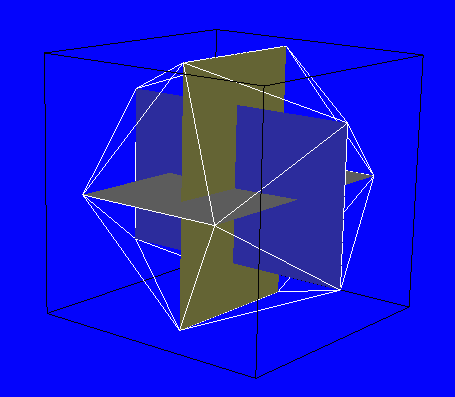CSE325
Computers and Sculpture
.
Build: A paper and string model of an icosahedron using three
index cards. It looks roughly like the image above. The index
cards I gave out in class have holes drilled in the corners for string
to pass through. By cutting some slits, they fit through each other.
The edges of the icosahedron are made of string, except that you do not
need to run a string along the short edge of the index cards.
You can loop the string through the holes in one continuous cycle (an
Eulerian path). The string passes through each hole twice and
ends where it starts. Study the model to see how it provides an easy
way to see XYZ coordinates for each icosahedron vertex.
Label: Draw a positive X-axis, Y-axis, and Z-axis on your
model. Make sure it is a right-handed coordinate system. Our unit of
length is that the short edge of a card is 2 units, so the distance
from the center of that edge (where the axis is) to the corner is 1.
Label each vertex with its XYZ coordinates. Each X, Y, or Z coordinate
will be 0, +/- 1, or +/- 1.6. With a three-by-five- card, the
actual long/short ratio you have is 5/3 or 1.666. For an ideal
icosahedron, the actual ratio you want is about 1.61803. But to save
typing, just write it as 1.6. There are 20 triangles, so label the
paper with A, B, C, ... somewhere near the center of each triangle.
Type: Recall how we made an .stl file of a pyramid in class. Do
the analogous thing here. Cut and paste from the notes the syntactic
structure of the .stl file. Make spots for 20 triangles. Type the
coordinates of the 20 triangles in order A, B, C, .... Being systematic
will make it easier to track down any error you find when you view it.
View: Save your file and view it in any .stl viewer. A good
free one (the same one we have in class) is VisCam View.
Fix any missing or backwards faces. When you see an error, you can look
at the XYZ axes on the screen to determine which triangle has a
problem; then knowing which quadrant it is, you can find it on your
model and from the letter determine where in the file to look.
Submit: Send your .stl file to the TA as an email attachment.
Have the email subject line be CSE325HW-name-id. Have the file
name be the same but add ".stl" to the end. In
your email, write a sentence indicating whether you think all 20 faces
are correct or if there are remaining errors you could not track down
and fix.

